Family : Pomacentridae

Text © Giuseppe Mazza

English translation by Mario Beltramini
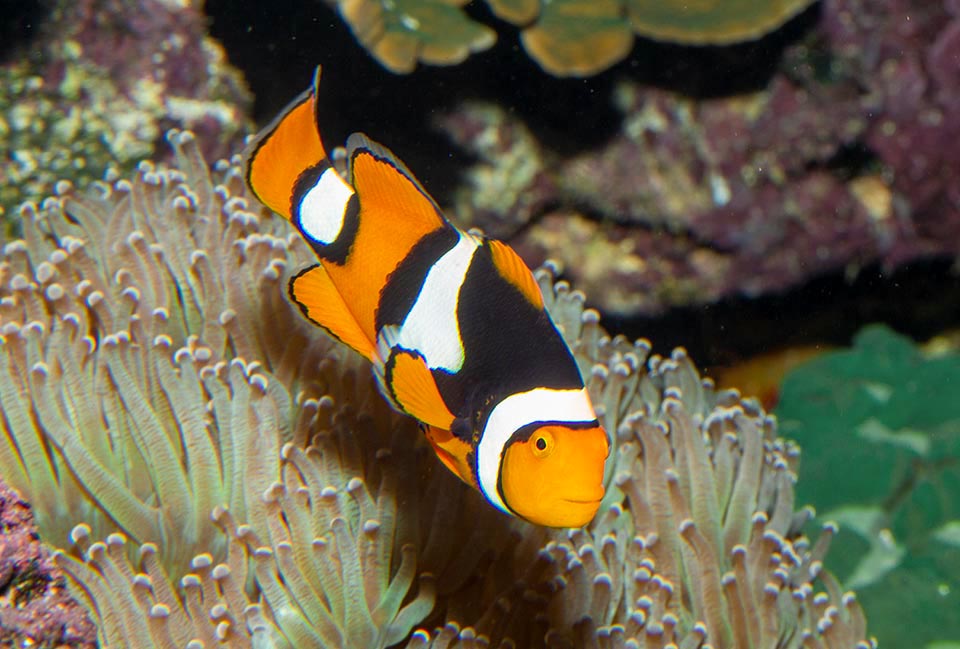
The Orange clownfish (Amphirion percula) is present in Southwest Pacific tropical waters. It distinguishes from Amphiprion ocellaris due to a more marked black edge near the white bands, that at times extends also over the back, the height of the body, that proportionally is lower, and one less spiny ray on the dorsal fin © Giuseppe Mazza
The Orange clownfish (Amphiprion percula Lacepède, 1802) belongs to the class of the Actinopterygii, the ray finned fishes, to the order of Perciformes, to the family of Pomacentridae and to subfamily Amphiprioninae, the clownfishes.
The name of the genus Amphiprion comes from the Greek “amphi” = “on both sides” and “priön” = saw, seen that on both sided of the head the preoperculum and the suboperculum are indented like a saw.
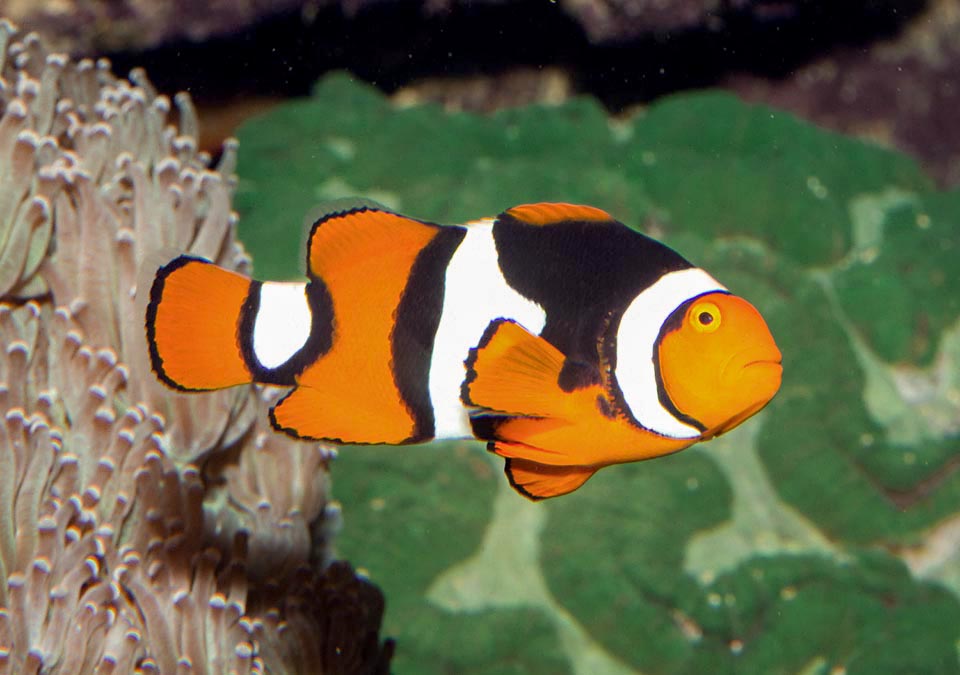
With a maximum of 11 cm in the females and 8 cm in the males, it’s one of the smallest clownfishes © Giuseppe Mazza
The name of the species, percula, is the Latin diminutive of “perca”, generic term used by the old Romans for indicating a fish, as well as, also, “perke” in Greek. In short it tells us simply that it is a little fish like its analogue Nemo, the likeable character of a famous cartoon.
Zoogeography
It s at home in the tropical waters of the Western Pacific Ocean.
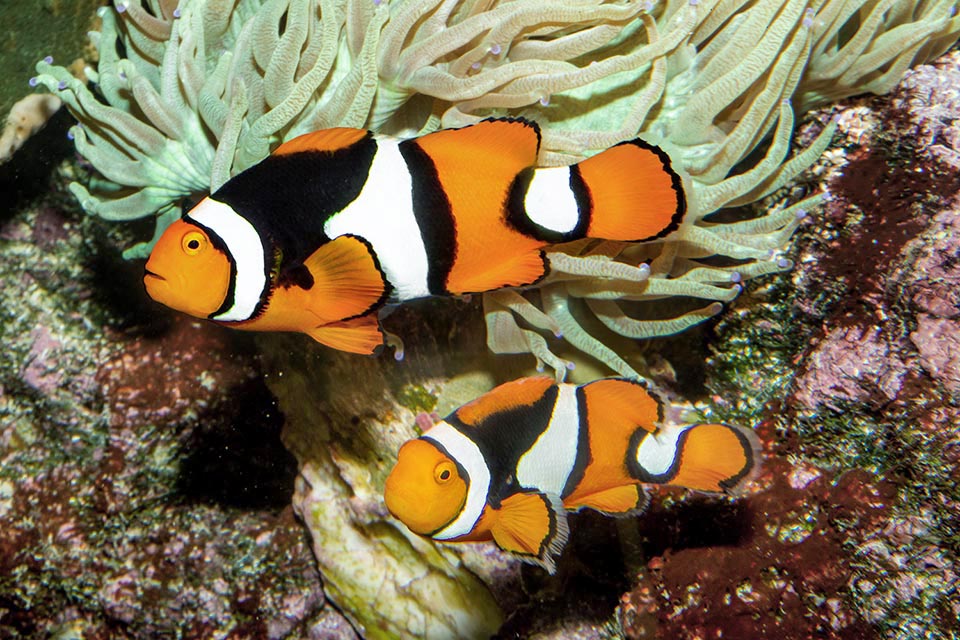
Lives symbiont with 3 actinias: Heteractis crispa, Heteractis magnifica and Stichodactyla gigantea that carefully cleans from parasites and wastes © Giuseppe Mazza
Indicatively, we find it in Indonesia, Philippines, Hong Kong and China, in New Guinea, in Australia along the Great Barrier Reef up to the Solomon Islands and Vanuatu.
Ecology-Habitat
It lives in shallow waters, up to 15 m of depth, sheltered by the urticant tentacles of three species of actinias: the Heteractis crispa, the Heteractis magnifica and the Stichodactyla gigantea.
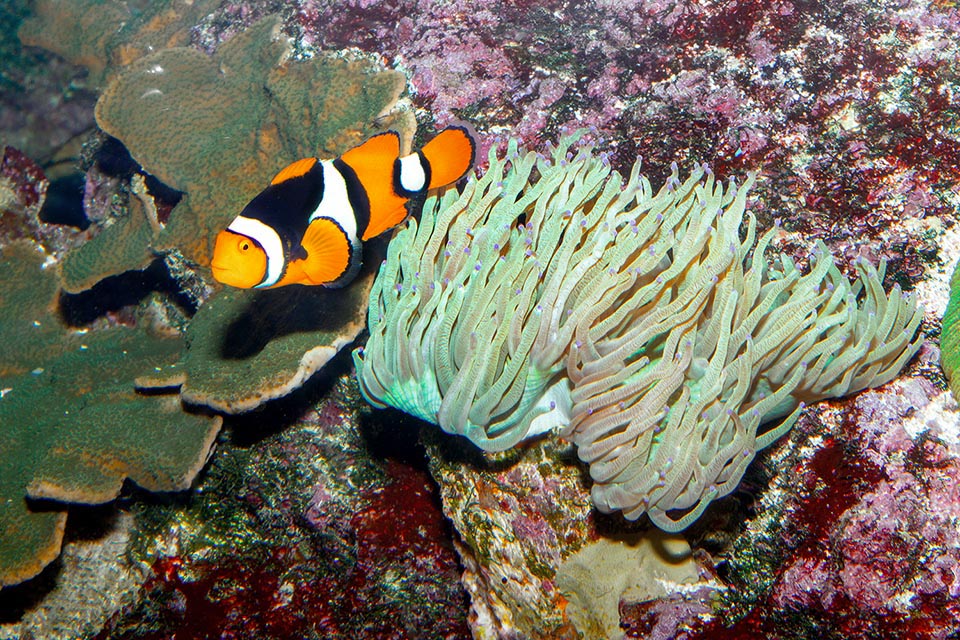
In return the sea anemone offers a safe shelter, deterring the predators with its stinging tentacles, harmless only to the Amphiprion © Giuseppe Mazza
Morphophysiology
This is one of the smallest clownfishes, with a maximum length of 11 cm in the females and 8 cm in the males.
Very much like the Amphiprion ocellaris, it distinguishes due to the dorsal fin which has, as an average, one spiny ray less, the black drawings wider and always present on the fins and the height of the body, which, proportionally, is lower. The dorsal fin has 9-10 spiny rays plus 14-17 soft, the anal 2 spiny rays and 11-13 soft, whilst the pectoral ones, ample and roundish, count of 15-17 unarmed rays.
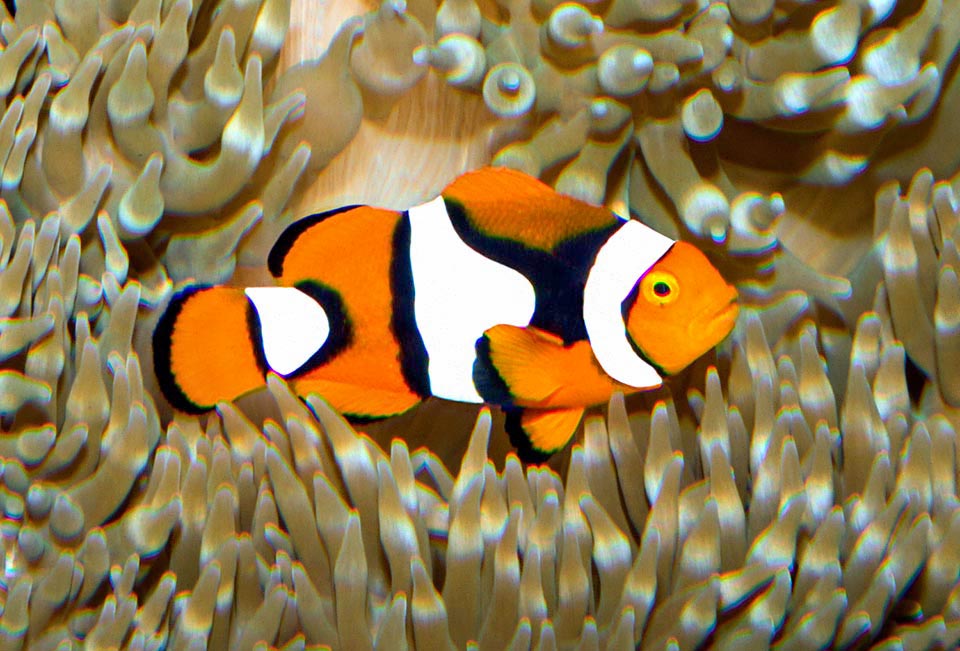
In this specimen the back black line is remarkably reduced and some specimens are entirely devoid of the same © Giuseppe Mazza
The ventral fins are more or less rounded, like the caudal, which tends to be truncated in the bigger specimens.
On the background colour, yellow-orange, stand out three wide white vertical bands intended to break the contour of the fish. They go from side to side like a saddle, emphasized by a black border. The first stands between the eye and the operculum, the second, wider and protruding forward with a loop, in the mid of the body and the third at level of the caudal peduncle.
The fins, having the same colour as the body and often translucent on the border, have almost always showy black contours.
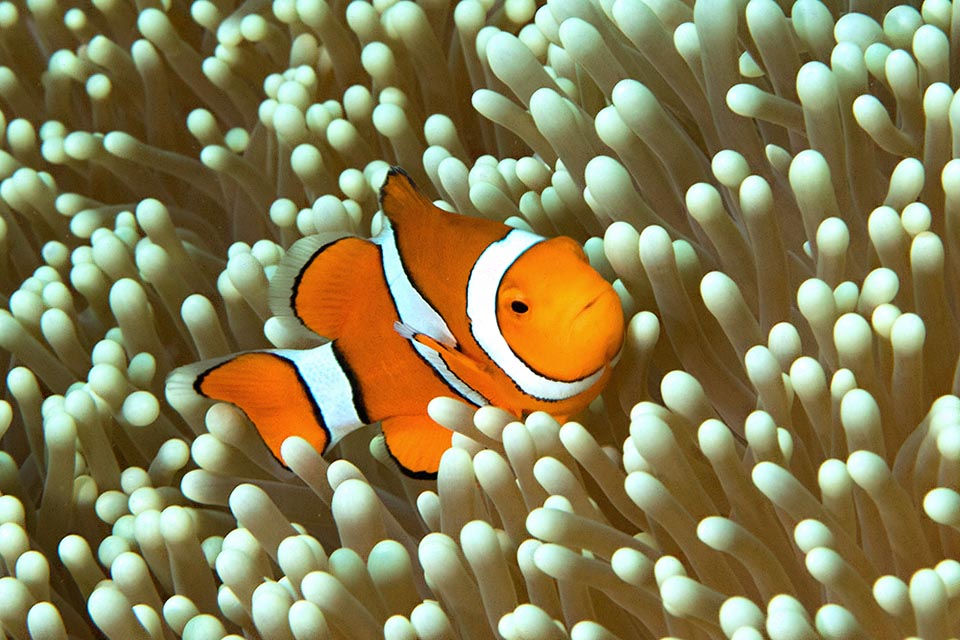
Here in fact it’s absent, and also the black bands are thinner. Clownfish never goes far away from its shelter, eating algae, plankton and small invertebrates © Paddy Ryan
Ethology-Reproductive Biology
Like all clownfishes, it lives in symbiosis with actinias having urticant tentacles. Thanks to the mucus covering the scales, the juveniles become gradually insensible to the poison of the host which becomes a safe den, where to shelter when the predators are around. In exchange, they do the cleaning, eliminating the leftovers and the parasites of the actinia, and protect the same from the fishes which have the bad habit of nibbling its tentacles.
The Amphiprion percula nourishes of algae and small planktonic invertebrates.
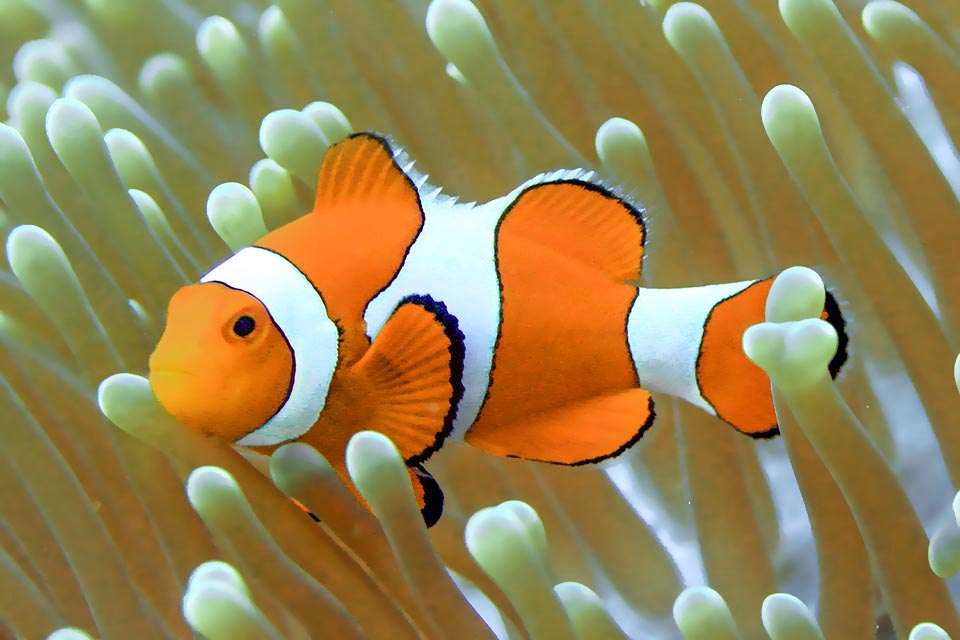
Here the black bands are so thin that it might be mistaken with an Amphiprion ocellaris. They live in communities, more or less numerous depending on size of host, formed by only one female, the queen, reaching a maximum of 11 cm and smaller males. When she dies the biggest one changes sex and takes over her place © Keoki Stender
It is a protandric hermaphrodite speces: this means that the males transform in females once a certain age is reached. Usually, the actinia hosts one pair, but if the size allows this other immature males may add, thus forming a small community led by one female, recognizable at sight because more courageous and bigger.
When this one dies, in a few weeks the breeding male changes of sex and the second in the hierarchy takes its place. The possible fights for the power happen, therefore, only among males.
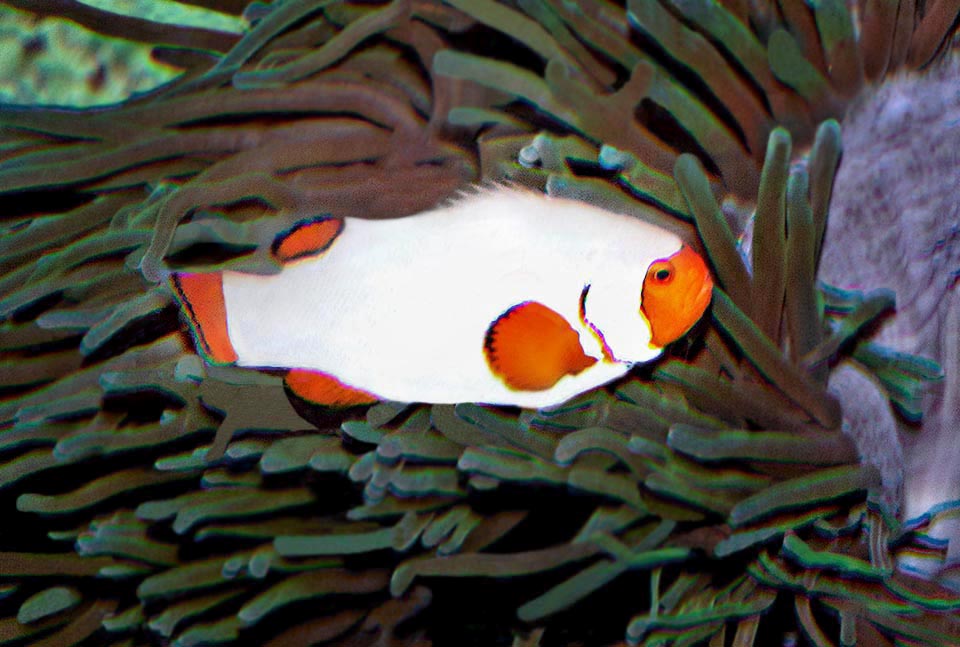
Hybrid of Amphiprion ocellaris x Amphiprion percula. Both species do reproduce in captivity and are raised for the aquarium market © Giuseppe Mazza
For the reproduction, the eggs are stuck at the feet of the actinia, on the underlying rock. The dominant male fecundates them and watches them, ventilating them with its fins, till when the hatching takes place, when the larvae will be taken off by the currents.
The Amphiprion percula reproduces in captivity and is often bred for the trade. In nature the populations may double in 15 months and have borne well, without harms, the degradations connected with the climate change. Therefore, the species enjoys nowadays of a very low vulnerability index: only 23 on a scale of 100.
Synonyms
Lutjanus percula Lacepède, 1802; Actinicola percula Lacepède, 1802; Amphiprion tunicatus Cuvier, 1830.
→ For general information about FISH please click here.
→ For general information about BONY FISH please click here
→ For general information about CARTILAGINOUS FISH please click here.
→ To appreciate the BIODIVERSITY of BONY FISH please click here.
→ To appreciate the BIODIVERSITY of CARTILAGINOUS FISH please click here.
